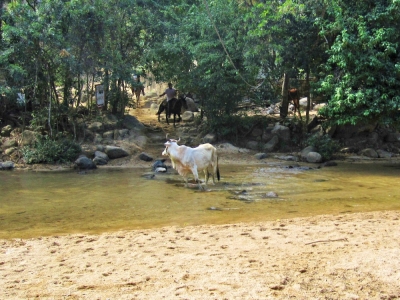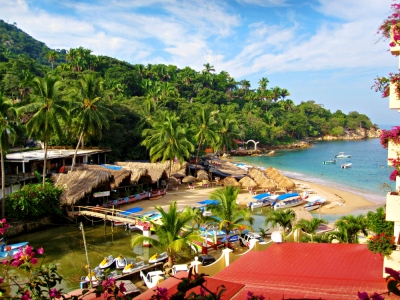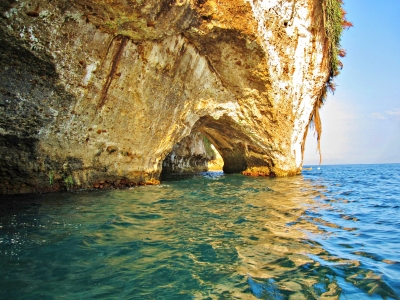
Running With The Bulls In The Outskirts Of Puerto Vallarta
If I know Hemingway – and I think I do – my guess is he would have been laughing his ass off. We were laughing in the beginning, until we realized that the bull was certainly not.
Let me catch you up: The village of Mismaloya is on the southern outskirts of Puerto Vallarta, and I’m not being cute by using the word village. Dirt roads, minimal infrastructure, and clothes lines are what you first notice, the village split in the middle by the winding road that takes you into town. Upon first engaging one of the residents, you’re most likely to get a smile and a sales pitch. On the beach end, you’ll find restaurants and boat tours. Inland, tacos and tequila.
Once you get them talking, once you get past the idea of them wanting to sell you something, you start to get a feeling for the simple life they live by the sea. It’s so easy to put your hand up when they approach, tell them you’re not interested before the conversation even gets started, but I would advise against that. When Romero approached us on the beach, not only did we find out we could take a four-hour snorkel, fishing, and hiking boat tour for dirt cheap ($200/six people), we learned that he grew up in Washington and moved here because he enjoyed the lifestyle, enjoyed meeting new people and boating and fishing everyday. Call me crazy, but methinks that boy’s got his head on straight.
We met him the next morning on the beach as the sun breached the green, lush mountain top. Sunglasses on faces and beers in backpacks, we cruised out of Mismaloya and trolled a line. We took in the coastline, enjoying the morning at sea, and eventually caught an albacore tuna (see below for photos of the feast). Our first stop was the rock formations of Los Archos, a popular snorkel area in between Mismaloya and Puerto Vallarta. It’s a photogenic spot with a lot of fish and good coral, although make sure you go at off times as large tour groups can crowd it mid-day.
Now about that damn bull: The village of Quimixto is south of Mismaloya and only accessible by boat and our guide, Romero, decided he wanted to take us there and show us to a waterfall. It’s not exactly a remote village – Vallarta Adventures runs horseback riding tours through it – but it’s beautiful and you can escape the touristy vibe if you go with a small group and avoid encounters with the aforementioned horseback riding excursions.
We were successful in that department for the first part of the trip, hiking to the waterfall and swimming below in its refreshing waters (I climbed the falls as well… see photos). It was a great find, and I had a beer at the restaurant, listening to the water fall into the water, before putting my wet feet back into my socks and tying my shoes.
On the way back down was when things got interesting. We encountered a stopped-in-their-tracks horseback riding tour, most of them staring down at what we initially believed to be a sick/dying horse or cow. As we got closer, we saw that it was a bull, and that it was very much alive and healthy. Mostly, though, it was irritated. He was in the process of being led down the mountain by two “cowboys,” and upon encountering the group the bull had freaked out, and the boys had to drag him to the ground by the rope around his neck. That said, things looked under control, and we passed by without a scene. Obviously, that all changed. A handful of minutes later – I couldn’t even tell you at this point whether it was 5 or 15 – we were making our way through a narrow part of the trail, where the land rose up sharply on either side, funneling anything in the middle down the mountain. As we would soon learn, it is not a good place to be when a charging bull has gotten too far in front of inexperienced cowboys. It’s sort of like when the dog walks the owner, a game of constant catch up.

Running With The Bulls In The Outskirts Of Puerto Vallarta
It all happened so fast. We scrambled, ducking for cover wherever we could, throwing ourselves behind trees. The boys had no control over the bull or its direction, allowing it to entertain its frustration and pursue us, backing one of my friends up against a barbed-wire fence. Three more feet of “leash” and this would be the printed on a police report instead of a travel site. Grabbed from behind by the horns, the bull fell to the ground at the feet of my friend, the rest of us looking on with raised eyebrows, wide eyes, and racing hearts.
Stunned, we saw the cowboy turn and yell at us in Spanish. He wanted us to get going. We collected ourselves and carefully circled around the now fallen bull, still trying to figure out if we were all right. About five minutes later, in an out-of-sight-out-of-mind sort of way, the world seemed calm again. We had survived, and laughter started to surface. I smiled at the sight of the ocean and stopped to take a few photos, letting the others go ahead. It was a beautiful view from the hillside with a dense forest of green leaves between myself and the ocean. I stood with a barbed-wire fence just over waist high, admiring the view, but noticing the fence’s presence on both sides of the trail. A thought came to my head: Why did we go in front of the bull? I thought I heard something, and I was right.
Around the corner, about 50 yards behind me, the bull came charging, the cowboys in close pursuit. There was nowhere to go given the fences – a full on sprint was the only option. When I caught up to my friends and our guide, I was at full speed and shouting as loud as I could, and the seven of us pounded through the flowing water of the stream without slowing, jumping a fence across the way and ducking into the yard of one of the village residents. We had created some space, and like spies in a bunker, we peered over the fence and waited. Down the hill the bull came, stomping through the river as if on a mission, the head going side-to-side, right on past us down the trail.
The cowboys, watching a safe distance behind from upon their horses, slowed down to cross the stream before continuing the chase.







